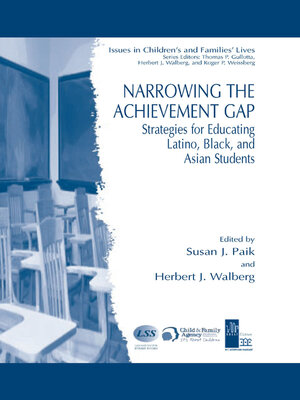Narrowing the Achievement Gap
ebook ∣ Strategies for Educating Latino, Black, and Asian Students · Issues in Children's and Families' Lives
By Susan J. Paik

Sign up to save your library
With an OverDrive account, you can save your favorite libraries for at-a-glance information about availability. Find out more about OverDrive accounts.
Find this title in Libby, the library reading app by OverDrive.



Search for a digital library with this title
Title found at these libraries:
| Library Name | Distance |
|---|---|
| Loading... |
The subject of minority children's learning has long been the concern of civic leaders, parents, scholars, and educators. The federal legislation, 'No Child Left Behind' emphasizes the concern even more. It specifically requires assessing the academic achievement of minority students, particularly in economically disadvantaged areas, and holding schools accountable for their progress. Schools that fail to attain "Adequate Yearly Progress" face the real possibility of being forced to close if they continually fail to perform. Unlike the past, these are increasingly "high stakes" consequences for educators, parents, students and the schools that serve them. This book is timely and relevant because it addresses these issues, and recommends solutions for Latino, Black, and Asian students. This book also has implications for the problems the nation faces in helping all students to learn well, particularly those that lag in academic achievement. In considering the broad problems and in recommending solutions, the book provides breadth, concision, and unique organization. As the introductory chapter makes clear, the book simultaneously considers not only the three most visible minority groups in the U. S. , but draws upon the perspectives of anthropology, education, ethnic studies, psychology, and sociology. From these several persp- tives, this book is organized within three broad sections: 1) culturally diverse families and schooling; 2) issues of immigration and schooling experiences; and 3) socio-cultural perspectives on teaching, learning, and development. Within each section, the authors marshal research literature regarding each ethnic minority group.







